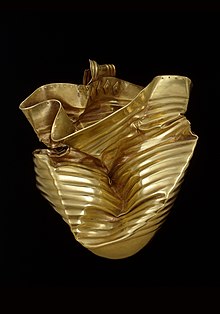Ringlemere Cup
| Ringlemere Cup | |
|---|---|
 | |
| Material | Gold |
| Created | 1700-1500 BC |
| Discovered | Ringlemere barrow in 2001 |
| Present location | British Museum |
The Ringlemere Gold Cup is a Bronze Age vessel found in the Ringlemere barrow near Sandwich in the English county of Kent in 2001.
Description
The body of the cup was created by hammering a single piece of gold, with the handle cut from a flat strip of gold and attached by rivets.[1] Although badly crushed by recent plough damage[citation needed] it can be seen to have been 14 cm high with corrugated sides. The cup resembles a late Neolithic (approximately 2300 BC) ceramic beaker with Corded Ware decoration, but dates to a much later period.
It is thought that the cup was not a grave good, but a votive offering independent of any inhumation, which was placed at the centre of the barrow in about 1700–1500 BC. No contemporary burials have been found at the site, although later Iron Age ones have since been found, along with a Saxon cemetery.
Only seven similar gold "unstable handled cups" (unstable because round-bottomed) have been found in Europe, all dating to the period between 1700 and 1500 BC. The Ringlemere cup is most similar to the other British example, the

Discovery, purchase and display
The cup was discovered by
After discovery of the cup, the site was excavated between 2002 and 2005 revealing a history starting with activity in the Mesolithic period, a number of Neolithic features and finds, a funerary complex of Early Bronze Age date (approximately 2300 BC), and an Anglo-Saxon cemetery.[6]
The cup was number 10 in the list of British archaeological finds selected by experts at the
From 14 May 2004 until 13 January 2006 the cup appeared in the museum's "Buried Treasure" exhibition on treasure trove, both at the museum itself and touring (to the National Museum & Gallery of Wales at Cardiff, Manchester Museum, the Hancock Museum at Newcastle, and the Norwich Castle Museum & Art Gallery). On its return to London, it was on temporary display in Room 2 of the British Museum, with the Rillaton cup, until 17 October 2006. From 17 October to 26 February 2007 it was on temporary display in Dover Museum, closer to its find-spot, and it is now back in the Prehistory galleries at the British Museum.[3]
See also
Notes
References
- Needham, Stuart; Parfitt, Keith; Varndell, Gillian (Eds) The Ringlemere Cup: Precious Cups and the Beginning of the Channel Bronze Age, 2006, British Museum Research Publication 163, ISBN 978-086159-163-3
- Hobbs, Richard (2003), Treasure : finding our past, British Museum, ISBN 978-0-7141-2321-9
